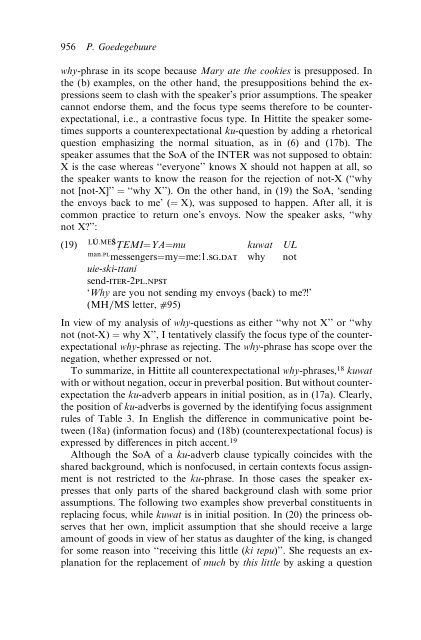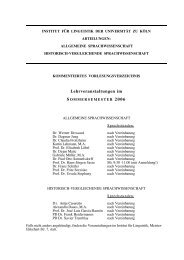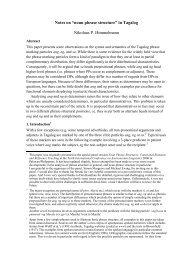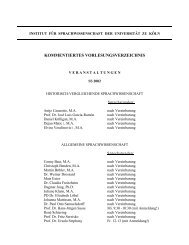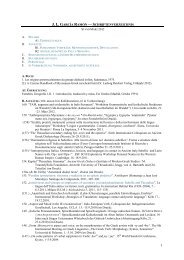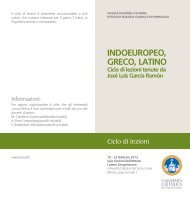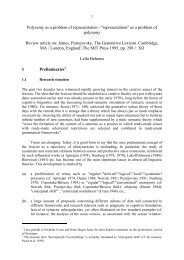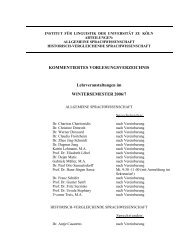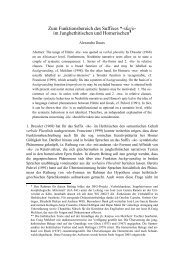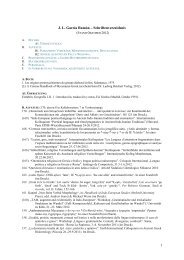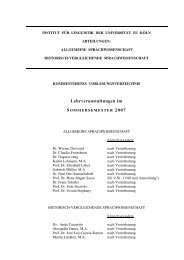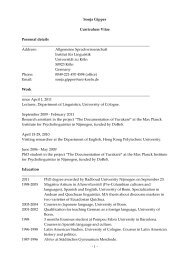Topics in Anatolian Historical Grammar Prof. Dr. H. Craig Melchert
Topics in Anatolian Historical Grammar Prof. Dr. H. Craig Melchert
Topics in Anatolian Historical Grammar Prof. Dr. H. Craig Melchert
You also want an ePaper? Increase the reach of your titles
YUMPU automatically turns print PDFs into web optimized ePapers that Google loves.
956 P. Goedegebuure<br />
why-phrase <strong>in</strong> its scope because Mary ate the cookies is presupposed. In<br />
the (b) examples, on the other hand, the presuppositions beh<strong>in</strong>d the expressions<br />
seem to clash with the speaker’s prior assumptions. The speaker<br />
cannot endorse them, and the focus type seems therefore to be counterexpectational,<br />
i.e., a contrastive focus type. In Hittite the speaker sometimes<br />
supports a counterexpectational ku-question by add<strong>in</strong>g a rhetorical<br />
question emphasiz<strong>in</strong>g the normal situation, as <strong>in</strong> (6) and (17b). The<br />
speaker assumes that the SoA of the INTER was not supposed to obta<strong>in</strong>:<br />
X is the case whereas ‘‘everyone’’ knows X should not happen at all, so<br />
the speaker wants to know the reason for the rejection of not-X (‘‘why<br />
not [not-X]’’ ¼ ‘‘why X’’). On the other hand, <strong>in</strong> (19) the SoA, ‘send<strong>in</strong>g<br />
the envoys back to me’ (¼ X), was supposed to happen. After all, it is<br />
common practice to return one’s envoys. Now the speaker asks, ‘‘why<br />
not X?’’:<br />
LU:ME (19) S ṪEMI¼YA¼mu kuwat UL<br />
man:pl messengers¼my¼me:1.sg.dat why not<br />
uie-ski-ttani<br />
send-iter-2pl.npst<br />
‘Why are you not send<strong>in</strong>g my envoys (back) to me?!’<br />
(MH/MS letter, a95)<br />
In view of my analysis of why-questions as either ‘‘why not X’’ or ‘‘why<br />
not (not-X) ¼ why X’’, I tentatively classify the focus type of the counterexpectational<br />
why-phrase as reject<strong>in</strong>g. The why-phrase has scope over the<br />
negation, whether expressed or not.<br />
To summarize, <strong>in</strong> Hittite all counterexpectational why-phrases, 18 kuwat<br />
with or without negation, occur <strong>in</strong> preverbal position. But without counterexpectation<br />
the ku-adverb appears <strong>in</strong> <strong>in</strong>itial position, as <strong>in</strong> (17a). Clearly,<br />
the position of ku-adverbs is governed by the identify<strong>in</strong>g focus assignment<br />
rules of Table 3. In English the di¤erence <strong>in</strong> communicative po<strong>in</strong>t between<br />
(18a) (<strong>in</strong>formation focus) and (18b) (counterexpectational focus) is<br />
expressed by di¤erences <strong>in</strong> pitch accent. 19<br />
Although the SoA of a ku-adverb clause typically co<strong>in</strong>cides with the<br />
shared background, which is nonfocused, <strong>in</strong> certa<strong>in</strong> contexts focus assignment<br />
is not restricted to the ku-phrase. In those cases the speaker expresses<br />
that only parts of the shared background clash with some prior<br />
assumptions. The follow<strong>in</strong>g two examples show preverbal constituents <strong>in</strong><br />
replac<strong>in</strong>g focus, while kuwat is <strong>in</strong> <strong>in</strong>itial position. In (20) the pr<strong>in</strong>cess observes<br />
that her own, implicit assumption that she should receive a large<br />
amount of goods <strong>in</strong> view of her status as daughter of the k<strong>in</strong>g, is changed<br />
for some reason <strong>in</strong>to ‘‘receiv<strong>in</strong>g this little (ki tepu)’’. She requests an explanation<br />
for the replacement of much by this little by ask<strong>in</strong>g a question


